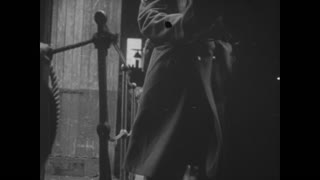This documentary “Tunisian Victory” (1944) shows the combined effort of US and British forces in the North African campaign of WWII. It breaks down Operation Acrobat leading to the liberation of Tunisia. The narrative is relayed through documentary footage and narration by Burgess Meredith and Bernard Miles recounting the experience of British and American soldiers. “Tunisia Victory” was created to be a follow up of the British documentary “Desert Victory” of 1943. Operation Acrobat would ultimately be successful in preventing the Axis powers from joining with Iran and isolating Russia and China. The film continues following the aftermath of the North African landings to show the critical tank clash on November 25th, the pass through the Great Dorsal mountains as well as the massive buildup of war materials from U.S. and British factories for the major battle in Tunisia.
00:00 It is presented by US and British governments (:14). The title screen follows (:24); produced by British and American Service Film Units (:30) and distributed by the British Ministry of Information (:37). An observer peers through binoculars atop a Navy destroyer (:49). Soldiers man anti-aircraft guns (:58). Wide shots show the massive armada on the waters (1:06). Radio men hammer onto telegraph machines (1:14). British battleships (1:22) move southward from Britain with destroyer escorts (1:38). A Douglas SBD Dive bomber (1:47) zips by. Preparation for this operation in Washington DC, June 18th, 1942 (2:19). Winston Churchill and FDR (2:23) arrive in Chrysler Imperials. Chief of Staff hats (2:37) sit on shelves during the meeting. Maps show the current positions Axis powers (2:52) and the planned drive forward. By morning FDR and Churchill (3:43) had planned Operation Acrobat (4:05). Industry workers head for work as the war machine geared up (4:27). Combat troops climb from watery trench positions (5:22), flamethrowers lick out (5:25), new warships enter the fleet (5:27), Boeing planes were manufactured (5:44) and new M-10 tank destroyers roll out (5:47). The US supply line moved eastward (6:07). The British supply line (6:25) follows. Lancaster bombers (6:34). Stevadores load munitions (7:05), food supplies (7:15) and locomotives (7:17). En route (8:55) the convoy engages in conflict with an enemy submarine. Troops are handed guide books (10:44) informing them of their ultimate destination. A news bulletin from November 8th 1942 details the Eighth Army’s successful offensive (13:30). Bombs fall over Genoa (13:42), Naples (13:47) and the Renault factory (13:53). Submarines (14:03) manned by forces under General Mark Clark (14:05) head for Africa. General Eisenhower joined with Henri Giraud (14:17). Ships pass straits of Gibraltar (14:29). U.S. Navy ships flash signals (15:23) off Casablanca. General Patton addressed soldiers (15:32). A bulletin from November 8th 1942 (16:04) began the offensive. Charles de Gaulle speaks over a short-wave radio (16:53) as the French welcomed Allied forces. The code words “play ball” are heard as combat erupts on the shores of Algiers (17:57). Troops storm the beaches (18:29). Admiral Jean Darlan (18:44), Marshal Petain and their troops surrender the city (18:53). US paratroopers drop over Oran (18:59). Shore batteries (20:15) wind gun mounts of the heavy French battleship Jean Bart (20:19). Shock troops make for Saint Leu (21:30). Germans invade France (21:48). Admiral Darlan (21:51) orders cessation of hostiles. German armistices (22:03) flee. General Anderson and the first army arrive in Algiers (22:27). German forces flood into Tunis (23:00). Aerial shots pass over Luftwaffe airfields (23:54); the German advantages are discussed. Luftwaffe attack Allied captured airfields (25:02). German Field Marshal Albert Kesselring arrives on North African soil (25:48). Allied forces arrive in Beja November 22nd (26:36). A tank battle erupts on November 25th (27:19). Allied troops arrive within view of Tunis (28:13). Luftwaffe bombs fall (28:27). Airfields flooded in bad weather (29:39). The Battle of Kasserine Pass took place in a two-mile gap of the Great Dorsal chain (30:43). Consolidated B-24 Liberators take off (33:31). P-38’s fly out from Brazil (35:46). New airstrips are constructed (36:25). Ancient ruins of Tunisia appear as the country was set to be a major campaign (37:01). Closing scenes show Christmas of 1942 (38:04).
This film is part of the Periscope Film LLC archive, one of the largest historic military, transportation, and aviation stock footage collections in the USA. Entirely film backed, this material is available for licensing in 24p HD, 2k and 4k. For more information visit http://www.PeriscopeFilm.com


